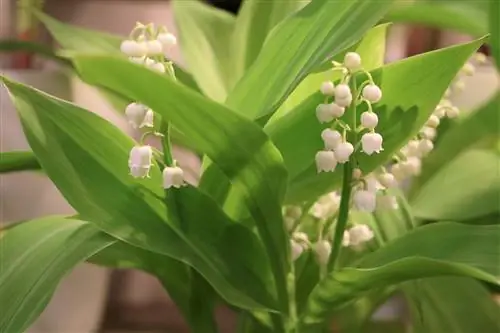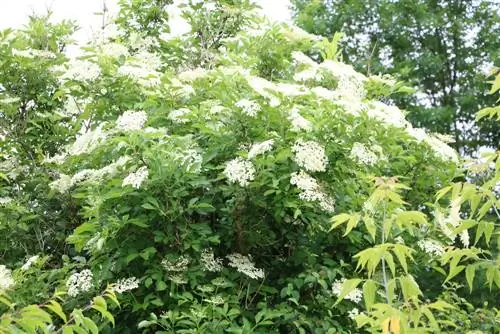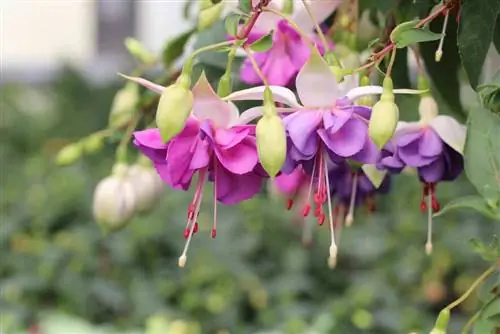- Author admin [email protected].
- Public 2023-12-17 03:39.
- Last modified 2025-01-24 12:45.
The magnificent spars bloom in different sizes and colors in the shade garden from summer until autumn. There are magnificent spars in many different sizes and colors, from short to tall, from bright white to delicate pink tones to dark red flowering varieties. In late summer and autumn, the hydrangeas shine in the shade garden. Here too, in addition to varieties that grow very tall, there are now others that remain a little lower. In addition to the more traditional shades of blue, pink or purple, hydrangeas have also been joined by a number of new, interesting shades that delight the eye with their wonderful flowers.
Here again the types mentioned for speed readers:
- wood anemones
- Violets
- Lilac
- Rhododendrons
- Foxglove
- Columbine
- bleeding heart
- Magnificent Sparrows
- hydrangeas
Groundcover
There are also ground cover species that prefer shady places. These include, for example, the celandine, which shows its bright yellow flowers in spring, the white-flowering lilies of the valley, which delight the eye a little later, forest anemones or the blue periwinkle, which shows its many small flowers later and continues to bloom for a very long time. All of these ground covers are also hardy. A tip: Shade-loving species such as hostas and dogwoods, for example, come into their own among the ground cover plants. Not all, but many hosta species like shady places. Even though they only bloom for a while, hostas are beautiful ornamental plants because many of them have wonderfully colorful leaves that look beautiful almost all year round. The dogwood also likes shade. It is available with red and yellow branches that still shine beautifully in winter even without leaves. In spring the dogwood offers a great picture when the first delicate green leaves sprout on the colorful branches and offer the eye a wonderful contrast. Of course, hostas and dogwoods are also hardy shade plants.
Ferns as a green contrast
Even when they are not in bloom, ferns are a feast for the eyes among flowering shade perennials. The beautiful leaves of the ferns delight the viewer even without the showy flowers and are there to be admired all year round. Ferns are therefore very suitable for combining with flowering shade perennials in a shade garden because they really bring out their blooms. Ferns are also hardy. If you bring in some flowers from the garden for the vase, the leaves of the fern are also very suitable for additional decoration.
Now for the care
A shade garden has its own needs when it comes to care. Most shade perennials don't like too much digging and chopping. Nevertheless, the soil should remain permeable and not harden. The shade garden should not be too wet, but not too dry either. It is therefore always important to look at why a place in the garden is particularly shady. Under roof overhangs and trees with a dense canopy of leaves, you need to water enough, but not too much, so that the shade perennials underneath feel comfortable and can develop well. With trees this only happens in summer, but with roof overhangs it also happens when the trees don't have any leaves yet but the first tender shade perennials are already emerging or in late autumn the last shade perennials are still pleasing to the eye. Too much moisture can cause fungal growth, which should be avoided. In autumn it is good to add some fresh humus to the shade garden. This keeps him looser. Weeds should be carefully pulled out by hand, but not removed with a hoe, as such behavior would damage the shade perennials.
More answers to some questions
Which trees are good or bad to have near a shade garden?
Hawthorn, walnut or chestnut, for example, are well suited near a shade garden because they have deep roots. Shallow-rooted plants such as copper beeches, birches or Norway maples quickly withdraw too much water from the shade garden. Therefore, when planting trees, make sure to plant deep-rooted rather than shallow-rooted trees near your shade garden.
What to do if high walls in the shade garden cause too much moisture?
High walls sometimes disrupt air circulation in shade gardens and lead to a lot of moisture and then fungal infestation. It helps to cut back the plants more often and occasionally thin them out. It can also help to work sand such as quartz sand into the ground in such places. This makes the soil a little more permeable and the excess water can seep into the ground better.
What you should know about shade perennials in brief
- The bare spots under the large trees are often inhabited by snowdrops or lilies of the valley - typical shade perennials.
- The fern is also a shade plant. It also grows in the forest under the trees and gets little light. Fern is undemanding and easy to care for.
- Fern as a shade perennial can be planted well together with ivy. These two shade perennials get along well and complement each other.
- The ivy acts as a ground cover and its green, colorful leaves also offer variety to the eye.
- As flowering plants and shade perennials, the golden nettle can also be planted as a ground cover.
- The Christmas rose, the bluebell, orchid and foamwort also thrive and offer variety between the otherwise green plants.
- Scilla with the small blue flowers and the green hosta also thrive in the shade.
- Hosta is also available with striped leaves, similar in color to ivy.
Together with ground cover plants such as yews, which are very undemanding, and bergenias, you can use these plants to relax in a shady part of the garden and have a wonderful time there. Final tip: You can also plant rhododendrons and hydrangeas under trees as a splash of color. These plants have the advantage that they are slightly taller and therefore loosen up the area. This makes the overall impression more lively than just planting on one level. Anyone who dedicates a little love to these areas will find that they enjoy being there just as much or even more than in the sun with the brighter colors.






